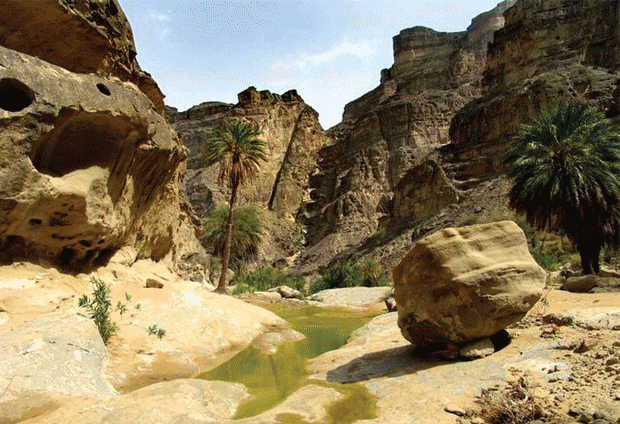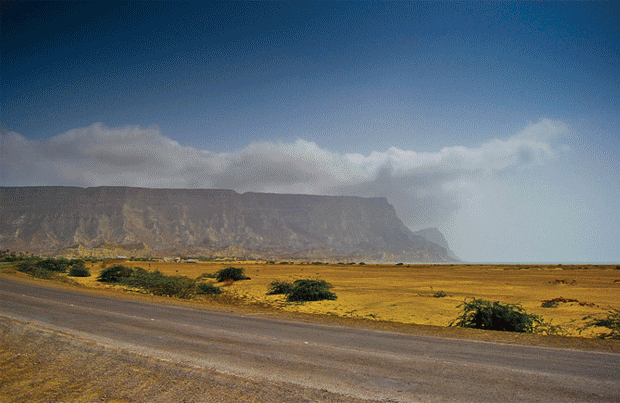|
Very few people have seen the Hingol National Park in
the Balochistan province of Pakistan. Its nearest approach is from
Karachi. Most visitors tend to go to the Hinglaj temple, an important
sight for Hindu pilgrims but we managed to go deep into the national
park with the Offroad pakistan who have made numerous visits there.
Hingol National Park or Hungol National Park is the largest of National
Parks of Pakistan. It is on the Makran coast in Balochistan and is
approximately 190 km from Karachi. The area was declared reserved in
1988.
The park area covers parts of the three districts: Lasbela, Gwadar and
Owaran of Balochistan province. It contains a variety of topographical
features and vegetation, varying from arid sub tropical forest in the
north to arid montane in the west. Large tracts of the NP are covered
with drift sand and can be classified as coastal semi desert. The
National Park includes the estuary of the Hingol river which supports a
significant diversity of bird and fish species.
|
|
 |
|
Currently, 20 staff members including 18 game watchers, two deputy
rangers are responsible for the management of the Park under the
guidance of the park Manager who reports to the Conservator and the
Secretary Wildlife, Forest, Livestock, Environment and Tourism.
The shrine of Devi Hinglaj, the holiest among the 51 Shakti Peeths of
Hinduism is situated in the park. It is a 15km trek from the main road.
There is also a dirt track that leads to the site. Several thousand
pilgrims visit the shrine each year.
Detailed inventories of wildlife were undertaken in 2006 and will be
completed in the first half of 2007. Hingol is known to support at least
35 species of mammals, 65 species of amphibians and reptiles and 185
species of birds. Some 250 plant species were recorded in the initial
surveys including 7 yet undescribed species. Many more species are yet
to be collected.
The park forms an excellent habitat to wild Sindh Ibex, Afghan Urial and
Chinkara Gazelle. Ibex is found in all steep mountain ranges and
numerous in the Hinglaj and Rodani Kacho Mountain areas. Total
population is estimated over 3000. The Urial populations are small and
occur in isolated populations. The Machi and Upper Pachhri Mountains
harbour the largest populations. Total population is less than 1000. The
Chinkara occurs in good numbers along the great rivers (Nal-Hingol, Arra,
Babro-Mar) in the Northern Plains and in the Harian and
Maniji-Gurangatti valley areas. Elsewhere populations have been
extirpated are very low. The total populations are preliminary estimated
between 800-1200.
|
|

|
|
The Hingol River banks, estuary and mudflats forms an important habitat
for migratory birds. About 40% of the bird species is related to water
habitats. Migratory birds listed to visit Hingol include Dalmatian and
Spot-billed Pelican, Sociable Plover, Spoonbills, Black Ibis, Black and
White Stork. The Houbara Bustard (Chlamydotis undulata) visits the
plains and valleys.
The River Hingol has been nurturing crocodiles for centuries. The Marsh
Crocodile (Crocodylus palustris) occurs over large areas along the
Hingol-Nal and some tributaries up to more than 100 km inland. The total
population is about 50. There are several beaches along the more than
100 km coastline, however few tirtles visit the beaches nowadays.
Historical records includes Olive Ridley (Lepidochelys olivacea) and
Green Marine Turtles (Chelonia mydas). The vulnerable Spiny Tail Lizard
(Uromastyx hardwickii) a mainly vegetarian lizard finds its most western
distribution in Hingol.
Mammals in the park include Leopard, Jungle Cat, Caracal and Indian
Desert Cat, Indian Fox, Bengal Fox and Sand Fox, Golden Jackal, Sindh
Ibex, Afghan Urial, Chinkara Gazelle, Honey Badger, Indian Pangolin,
Hedgehog (probably more than one species), Indian Crested Porcupine,
Indian Grey Mongoose, Five striped Palm Squirrel, Wild Boar, Cape Hare
and Desert Hare, Cairo Spiny mouse, Grey Spiny Mouse, Persian Jird,
Indian Desert Jird and Libyian Jird, House Mouse, Roof Rat, and Mouse
like Hamster. Wolf (Canis lupus pallipes) and Striped Hyena (Hyaena
hyaena) are on the brink of extinction. The Leopard and Caracal
populations are low.
The park has very few caves/ grottos, including one in the Dhrun
Mountains with a bat population.
|
|

|
|
Birds in the park include Houbara Bustard, Dalmatian and Spot-billed
Pelican, Bonnelli's eagle, Imperial eagle, Tawny eagle, Golden eagle,
Eurasian griffon vulture, Egyptian vulture, Cinereous vulture, Lagger
falcon, Red-headed merlin, Kestrel, Close-Barred sandgrouse, Grey
partridge, See See partridge, Stone Curlew, Indian sand grouse,
Coronetted sand grouse, Painted sand grouse, Eagle owl, Sind pied
woodpecker, Hume's chat, Brown rock pipit, Striped buning, Finche larks,
Hoopoe, Shrikes and Wheatears.
The Marsh Crocodile, Olive Ridley and Green Marine Turtles, Desert
Monitor lizard, Yellow Monitor lizard, and different species of lizard
and chameleon have been found in the park.
The government is all set to slice land off the Hingol National Park,
the country’s largest, as the Pakistan Air Force and another defence-related
organisation eye the prized real estate near the estuary whose value is
likely to increase phenomenally once the Gwadar port starts functioning.
Sources in the Balochistan revenue department told Dawn that while the
PAF has asked for around 80,000 acres (320 km²), including 23,000 acres
(93 km²) in the national park, Pakistan Space and Upper Atmosphere
Research Commission’s demand is for eight mauzas. |